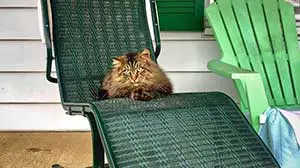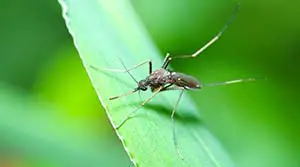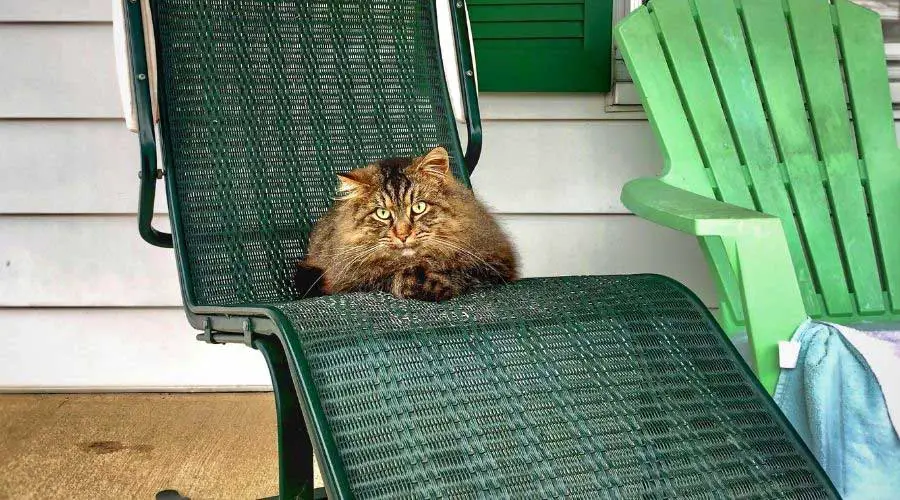
Most people go to great lengths to get comfortable tasteful outdoor furniture. However, if they are pet owners, they’re not the only ones that find their table nice and comfortable.
Their cats, especially, also like outdoor furniture. They’ll use any opportunity to lounge there, too. Sometimes the cats damage the furniture with scratches or territory marking.
Pet owners have to look for humane ways to keep cats off outdoor furniture. Make sure to follow these 12 practical ways to keep cats away:
- Install scratching posts away from the furniture
- Train your cat to stay off the furniture
- Install furniture protectors
- Use sticky tape
- Cover the furniture with aluminum foil
- Spray safe deterrent scents on the furniture
- Remove food sources
- Install motion-activated sprinklers
- Use PDB mothballs in cushions
- Spray commercially sold cat repellent
- Install an ultrasonic deterrent
- Consider trapping & neutering stray cats
Cats get on your furniture for a few reasons. They might want to feel comfortable, they want to scratch, or they need to feel good.
Realistically, it will take a while to get your cat off your outdoor furniture. So we prepared a guide that’ll help you. You may have to apply most of these tips at once to keep your cat furniture cat-free.
Why Do Cats Get On Outdoor Furniture?
Cats will leave the most comfortable kitty beds to sit on a lawn chair. It’s a cat thing. They often end up on furniture to scratch it or nap because it’s soothing to them.
Scratching the furniture could be because they want to stretch their paws or mark the territory. Unfortunately, it leaves the furnishings with unsightly scratch marks.
Also, it costs a lot of money to replace or repair defaced furniture. Getting them off your outdoor furniture means diverting their attention from the table first.
How to Keep Cats Off Your Outdoor Furniture
Here are some of the steps I found effective in keeping cats away from my outdoor furniture:
1. Install Scratching Posts Away from the Furniture
A scratching post may be the best investment you make for your cat. Most posts are thick wooden structures with woven sisal around them.
A woven sisal scratching post for your cat is an excellent choice because it’ll keep the cat’s nails safe, unlike a carpeted scratching post.
Cats like to mark stuff. Therefore, your purr baby will want to claim their post as soon as they get accustomed to it.
You can get the cat familiarized with the post much faster by using a catnip scent on the pole. Alternatively, try a design that takes advantage of the cat’s playful nature.
For example, a triangular scratching post allows you to hang a toy in the middle space. You just solved two problems in one fell swoop — boredom and scratching.

2. Train Your Cat to Stay Off the Furniture
Training your cat is proactive in keeping your cat off your outdoor furniture without using any products. Cat training, though, isn’t as easy as how you would train another pet like a dog.
Still, solid verbal commands over time take root in the cat. They learn that certain places are a no-go zone because of how you react.
A firm “NO” or “Down” is a good starting point whenever you see your cat on any piece of your outdoor furniture.
You can train your cat with negative reinforcement. Use the cold relationship between cats and water against your cat. Spray them with water whenever they don’t respond to a command to get off the furniture. They’ll learn to associate their climbing on the furnishings with the water spray.

3. Install Furniture Protectors
Furniture protectors are vinyl sheets you place wherever you find your cat scratches. They are transparent, meaning they don’t interfere with your outdoor furniture color theme. They’re also easy to install.
Peel off the protector and pin it on your furniture. The next time Mr. Scratchy Paws decides they want to play put-the-claws-on-the-seat with your furniture, their little paws will slide off the protector.
You can cover your entire furniture set with the protectors.
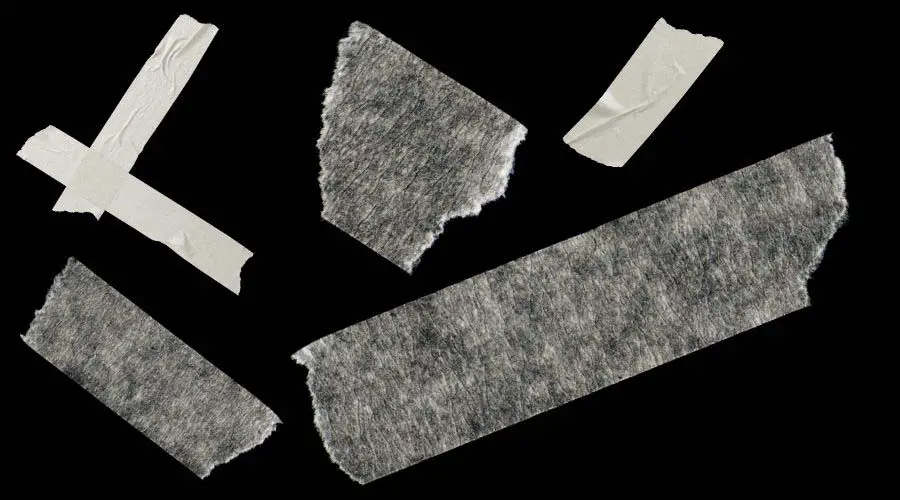
4. Use Sticky Tape
Cats are sensitive to what touches their paw pads. They don’t like the sticky feeling of sticky tape. You can also make a sticky tape for outdoor furniture without burning a hole in your pockets.
Get masking tape. Have the sticky side of one strip stuck to the furniture. Then place another strip on top of it with the sticky side up. Every time the cat steps on the sticky tape and feels the adhesion, the cat will back off the furniture.
Alternatively, buy double-sided training tape. It’s specially designed to deter cats from scratching your furniture.

5. Cover the Furniture with Aluminum Foil
Cats stepping on aluminum foil is a fun watch. They loath the loud sound it makes when they tiptoe on it. Placing it on areas they frequent teaches them to avoid that area.
Cover your seats with aluminum foil, especially if the seats have cushions—tuck in the aluminum foil to keep it in place. Lay the foil on the floor around the furniture. Doing so creates a buffer zone between the cat and the furnishings.
The upside of using aluminum is that the cat might pick up the habit of staying off that area even after you stop using foil. Also, you get the added benefit of not getting fur on any outdoor furniture cushions.
6. Spray Safe Deterrent Scents on the Furniture
Cats have an advanced sense of smell. Just like they use their scents to mask other cats’ scents, you can use their sharp sense of smell against them. Gather some fragrances to which they’re most sensitive. Make a spray and spritz it on the furniture.
The smell sticks to the furniture, making it a no-go zone for the cat. You don’t need to soak the area in the fragrance. Most scents are pretty strong and will likely last long before you need to reapply.
Before you think of commercial scents, use homemade scents. They’re not too harsh, and you can always make more if it’s a large outdoor area.
Potpourri is a safe smell you can use on outdoor furniture to keep cats off. It’s a mish-mash of dried and boiled peels, flowers, essential oils, and herbs. It makes your outdoor area smell wonderful while keeping it cat-free.
Scents that Cats Hate
Citrus
Citrus scents are such an effective repellent against cats. The best thing about citrus is how diverse it is. You can get it in so many fruits. Take fresh orange peels, lemon peels, tangerines, and lime. These are the most potent citrus fruits.
Boil them in a pot and let the water cool. Store in a spray bottle. Spritz the potent mixture anywhere you want your cat to keep off.
Alternatively, buy store-bought citrus-based essential oil and make different variations. However, remember to dilute the oils. They can be extra potent and might even overwhelm your cat.
Lemongrass Oil
There’s a reason why cats steer clear of any form of lemongrass. They’re not capable of processing lemongrass. As such, they have developed an aversion to any form of lemongrass.
It would be toxic to your cat if they ingested lemongrass oil. So, put a sun-dried, lemon oil scented rug in the cushion of your outdoor furniture.
The scent wafts through the cushion and keeps the cat away. All this is safe as the cat doesn’t contact any oil.
Wet Coffee Grounds
Coffee carries a strong smell that cats don’t like. However, coffee grounds should be more of an experiment to see if it works. Some cats are naturally hyper-curious, so they WILL smell it and maybe like it.
However, most people swear by the repulsing scent of coffee grounds. Spill some used coffee grounds where you wouldn’t want your cat. I wouldn’t advise you to spill it near seats, though. Try it in places where you have soil.
Vinegar
People use vinegar and apple cider vinegar as carrier fluids in many scent-based deterrents. Vinegar has a hint of acidity in its smell, and for some reason, cats can’t stand it. It’s not toxic to cats, though.
Still, limit any direct contact and minimize the risk of cats trying to taste the stuff. Lightly spraying cushions works perfectly.
Lavender
Cats get sick if they ingest lavender. For that reason, they avoid anything that smells like lavender. Lavender is so bad for cats that they would experience the same symptoms if they ingested lavender essential oil.
These symptoms include but are not limited to excess saliva production, nausea, vomiting, and cat depression. (Cat depression sounds sad.)
Spray a little lavender where you want your cat to keep off.
Peppermint
Peppermint and anything in the mint family is a no-no for cats. If your cat ingested any mint plants or anything with mint oil, you’d have to rush them to the vet.
They’d be vomiting and having diarrhea. As such, cats have developed an instinctual aversion to anything mint-scented.
Other plants in this group include menthol and wintergreen. A dash of peppermint on your outdoor furniture will ensure your cat doesn’t come close.
Eucalyptus
It’s no surprise that only pandas seem to stand the smell and taste of eucalyptus. It is toxic to most animals since they can’t digest it.
The strong eucalyptus smell repels cats. Cats would likely avoid any plantation with eucalyptus in it. So having anything that smells like eucalyptus on your yard furniture is a surefire way of keeping cats off.
Bananas
Cats and bananas have a peculiar relationship. Technically, cats CAN eat bananas. It won’t harm them. However, they can’t stand the smell of banana peels. And even when cats eat bananas, they only eat in small doses.
They will avoid any scent of bananas near your outdoor furniture. So you might want to toss some peels in a plant pot where your furnishings are.
How Do I Keep Stray Cats Off My Outdoor Furniture?
While you may have an easy time keeping your home cats off outdoor furniture, stray cats are different. They’re likely straying into your yard to look for food. These steps will work for house cats too. You’re only using them against stray cats since strays are unpredictable.

7. Remove Food Sources
If you feed your pets outside, any food remains will likely attract strays. Unfortunately, strays can get on your outdoor furniture and ruin it. Getting rid of any food outside is a proactive step to reducing instances of stray cats in your outdoor area.
Schedule feeding time and ensure you have a designated feeding spot in the house for your pets. Also, clean up any leftovers outside.

8. Install Motion-Activated Sprinklers
It doesn’t matter if it’s a house cat or a stray; water blasts and cats don’t mix. A motion-activated sprinkler system is a good stopper for keeping strays off your property even when you’re not home.
However, it works if the stray cat is within range. A sneaky stray cat that finds its way through your fence might get lucky.
Motion-activated sprinklers use heat signals and Infrared to detect animal movement from far. They’ll release a burst of water that’s just enough to startle the animal. You can adjust the settings according to the sensitivity you want.
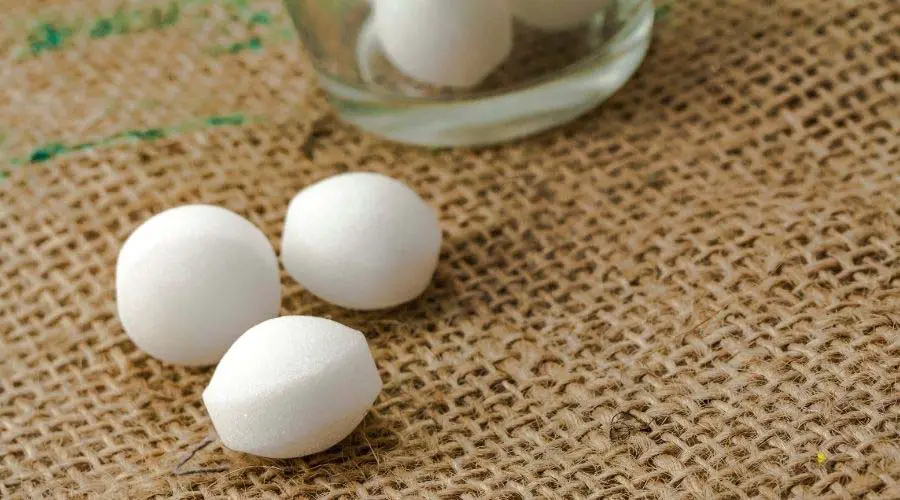
9. Use PDB Mothballs in Cushions
Mothballs contain heavy doses of insect repellant. Also, they smell awful. They’re highly toxic to cats and dogs. Dogs are more likely to eat mothballs because of their curiosity. Cats, though, avoid them.
There are two kinds of mothballs; naphthalene and PDB mothballs. PDB is less toxic. Therefore, you’ll find them in commercial repellants.
Place PDB mothballs in small bags and place them in strategic areas near outdoor furniture. The smell will keep stray cats off. They won’t ingest them, and you won’t be liable for any inhumane handling of animals.
10. Spray Commercially Sold Cat Repellent
There are many forms of cat repellent. Many spray cat repellents contain fox urine that sets off a cat’s natural defenses. They’re non-toxic, and they last a while on surfaces.
These are food for areas where you don’t sit. They limit entry when you spray them on fences and vulnerable entry points.
Alternatively, you can use repellents such as prickly mats. Place the prickly mats at the base of your outdoor furniture to keep stray cats from lurking nearby.
These mats, such as the Tapix Scat Mat, have plastic spikes that’ll feel uncomfortable for any stray cats.
Use them with other repellents since cats can quickly jump onto surfaces.

11. Install an Ultrasonic Deterrent
Ultrasonic deterrents emit sound waves the human ear can’t pick up. However, cats and dogs can pick up these sounds. The sound supposedly irritates cats and makes them stay away from an area.
Most of the products on the market have dismal ratings. Also, it would help if you only used ultrasonic deterrents as a last resort. They might work on some cats but fail in other instances.
Do Ultrasonic Deterrents Work Against Cats?
Ultrasonic Deterrents are a controversial product.
Some people claim they work while other trash its efficiency. However, the England-based Royal Society for the Protection of Birds claims ultrasonic deterrents worked to keep cats off the garden.
They claim the devices reduce cat visits into a garden by 32 percent.

12. Consider Trapping & Neutering Stray Cats
If you notice an overpopulation of unclaimed stray or feral cats in your neighborhood, you can take the initiative to neuter them.
The American Society for the Prevention of Cruelty to Animals (ASPCA) has a Trap-Neuter-Return that emphasizes the safe neutering of stray cats.
Alternatively, you can call the city department that deals with stray animals, and they can take care of the problem on your behalf.
Conclusion
You work hard to keep your outdoor furniture as good as new for as long as possible. You wouldn’t want your cat to ruin it with scratching and territory marking. These humane methods protect your furniture and ensure your cat or stray cats are safe.
Keep an eye out for any adverse reactions to any products and methods suggested here.
Sources







